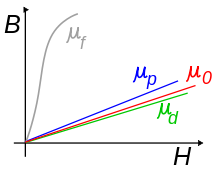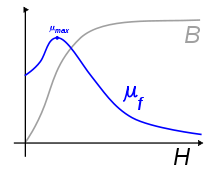- Permeability (electromagnetism)
-
Magnetic Circuits
Conventional Magnetic Circuits
Phasor Magnetic Circuits
Related Concepts- Magnetic permeability μ
Gyrator-capacitor model variables Simplified comparison of permeabilities for: ferromagnets (μf), paramagnets(μp), free space(μ0) and diamagnets (μd)
Simplified comparison of permeabilities for: ferromagnets (μf), paramagnets(μp), free space(μ0) and diamagnets (μd)
In electromagnetism, permeability is the measure of the ability of a material to support the formation of a magnetic field within itself. In other words, it is the degree of magnetization that a material obtains in response to an applied magnetic field. Magnetic permeability is typically represented by the Greek letter μ. The term was coined in September, 1885 by Oliver Heaviside. The reciprocal of magnetic permeability is magnetic reluctivity.
We can simplify it by saying, the more conductive a material is to a magnetic field, the higher its permeability.
In SI units, permeability is measured in the henry per metre (H·m−1), or newton per ampere squared (N·A−2). The permeability constant (μ0), also known as the magnetic constant or the permeability of free space, is a measure of the amount of resistance encountered when forming a magnetic field in a classical vacuum. The magnetic constant has the exact (defined)[1] value µ0 = 4π×10−7 ≈ 1.2566370614…×10−6 H·m−1 or N·A−2).
Contents
Explanation
In electromagnetism, the auxiliary magnetic field H represents how a magnetic field B influences the organization of magnetic dipoles in a given medium, including dipole migration and magnetic dipole reorientation. Its relation to permeability is
where the permeability μ is a scalar if the medium is isotropic or a second rank tensor for an anisotropic medium.
In general, permeability is not a constant, as it can vary with the position in the medium, the frequency of the field applied, humidity, temperature, and other parameters. In a nonlinear medium, the permeability can depend on the strength of the magnetic field. Permeability as a function of frequency can take on real or complex values. In ferromagnetic materials, the relationship between B and H exhibits both non-linearity and hysteresis: B is not a single-valued function of H,[2] but depends also on the history of the material. For these materials it is sometimes useful to consider the incremental permeability defined as
 .
.
This definition is useful in local linearizations of non-linear material behavior, for example in a Newton-Raphson iterative solution scheme that computes the changing saturation of a magnetic circuit.
Permeability is the inductance per unit length. In SI units, permeability is measured in henries per metre (H·m−1 = J/(A2·m) = N A−2). The auxiliary magnetic field H has dimensions current per unit length and is measured in units of amperes per metre (A m−1). The product μH thus has dimensions inductance times current per unit area (H·A/m2). But inductance is magnetic flux per unit current, so the product has dimensions magnetic flux per unit area. This is just the magnetic field B, which is measured in webers (volt-seconds) per square-metre (V·s/m2), or teslas (T).
B is related to the Lorentz force on a moving charge q:
 .
.
The charge q is given in coulombs (C), the velocity v in m/s, so that the force F is in newtons (N):
H is related to the magnetic dipole density. A magnetic dipole is a closed circulation of electric current. The dipole moment has dimensions current times area, units ampere square-metre (A·m2), and magnitude equal to the current around the loop times the area of the loop.[3] The H field at a distance from a dipole has magnitude proportional to the dipole moment divided by distance cubed,[4] which has dimensions current per unit length.
Relative permeability
Relative permeability, sometimes denoted by the symbol μr, is the ratio of the permeability of a specific medium to the permeability of free space given by the magnetic constant
 :
: .
.
In terms of relative permeability, the magnetic susceptibility is:
- χm = μr − 1.
χm, a dimensionless quantity, is sometimes called volumetric or bulk susceptibility, to distinguish it from χp (magnetic mass or specific susceptibility) and χM (molar or molar mass susceptibility).
Diamagnetism
Main article: DiamagnetismDiamagnetism is the property of an object which causes it to create a magnetic field in opposition of an externally applied magnetic field, thus causing a repulsive effect. Specifically, an external magnetic field alters the orbital velocity of electrons around their nuclei, thus changing the magnetic dipole moment in the direction opposing the external field. Diamagnets are materials with a magnetic permeability less than μ0 (a relative permeability less than 1).
Consequently, diamagnetism is a form of magnetism that a substance exhibits only in the presence of an externally applied magnetic field. It is generally a quite weak effect in most materials, although superconductors exhibit a strong effect.
Paramagnetism
Main article: ParamagnetismParamagnetism is a form of magnetism which occurs only in the presence of an externally applied magnetic field. Paramagnetic materials are attracted to magnetic fields, hence have a relative magnetic permeability greater than one (or, equivalently, a positive magnetic susceptibility). The magnetic moment induced by the applied field is linear in the field strength and rather weak. It typically requires a sensitive analytical balance to detect the effect. Unlike ferromagnets, paramagnets do not retain any magnetization in the absence of an externally applied magnetic field, because thermal motion causes the spins to become randomly oriented without it. Thus the total magnetization will drop to zero when the applied field is removed. Even in the presence of the field there is only a small induced magnetization because only a small fraction of the spins will be oriented by the field. This fraction is proportional to the field strength and this explains the linear dependency. The attraction experienced by ferromagnets is non-linear and much stronger, so that it is easily observed, for instance, in magnets on one's refrigerator.
Values for some common materials
The following table should be used with caution as the permeability of ferromagnetic materials varies greatly with field strength. For example 4% Si steel has an initial relative permeability (at or near 0T) of 2,000 and a maximum of 35,000[5] and, indeed, the relative permeability of any material at a sufficiently high field strength tends to 1.
Magnetic susceptibility and permeability data for selected materials Medium Susceptibility χm
(volumetric SI)Permeability μ [H/m] Relative Permeability μ/μ0 Magnetic field Frequency max. Metglas 1.25×10−1 1,000,000[6] at 0.5 T 100kHz Nanoperm 10×10−2 80,000[7] at 0.5 T 10kHz Mu-metal 2.5×10−2 20,000[8] at 0.002 T Mu-metal 50,000[9] Permalloy 1.0×10−2 8,000[8] at 0.002 T Electrical steel 5.0×10−3 4,000[8] at 0.002 T Ferrite (nickel zinc) 2.0×10−5 – 8.0×10−4 16–640 100 kHz ~ 1 MHz Ferrite (manganese zinc) >8.0×10−4 640 (or more) 100 kHz ~ 1 MHz Steel 8.75×10−4 100[8] at 0.002 T Nickel 1.25×10−4 100[8] – 600 at 0.002 T Neodymium magnet 1.05[10] Platinum 1.2569701×10−6 1.000265 Aluminum 2.22×10−5[11] 1.2566650×10−6 1.000022 Wood 1.00000043[11] Air 1.00000037 [12] Concrete 1[13] Vacuum 0 1.2566371×10−6 (μ0) 1[14] Hydrogen −2.2×10−9[11] 1.2566371×10−6 1.0000000 Teflon 1.2567×10−6[8] 1.0000 Sapphire −2.1×10−7 1.2566368×10−6 0.99999976 Copper −6.4×10−6
or −9.2×10−6[11]1.2566290×10−6 0.999994 Water −8.0×10−6 1.2566270×10−6 0.999992 Bismuth −1.66×10−4 0.999834 Superconductors −1 0 0 A good magnetic core material must have high permeability.[citation needed]
For magnetic levitation a relative permeability below 1 is needed (corresponding to a negative susceptibility).
Permeability varies with magnetic field. Values shown above are approximate and valid only at the magnetic fields shown. Moreover, they are given for a zero frequency; in practice, the permeability is generally a function of the frequency. When frequency is considered the permeability can be complex, corresponding to the in phase and out of phase response.
Note that the magnetic constant μ0 has an exact value in SI units (that is, there is no uncertainty in its value), because the definition of the ampere fixes its value to 4π × 10−7 H/m exactly.
Complex permeability
A useful tool for dealing with high frequency magnetic effects is the complex permeability. While at low frequencies in a linear material the magnetic field and the auxiliary magnetic field are simply proportional to each other through some scalar permeability, at high frequencies these quantities will react to each other with some lag time.[15] These fields can be written as phasors, such that
where δ is the phase delay of B from H. Understanding permeability as the ratio of the magnetic field to the auxiliary magnetic field, the ratio of the phasors can be written and simplified as
 ,
,
so that the permeability becomes a complex number. By Euler's formula, the complex permeability can be translated from polar to rectangular form,
 .
.
The ratio of the imaginary to the real part of the complex permeability is called the loss tangent,
 ,
,
which provides a measure of how much power is lost in a material versus how much is stored.
See also
- Antiferromagnetism
- Diamagnetism
- Electromagnet
- Ferromagnetism
- Figure of merit
- Magnetic reluctance
- Paramagnetism
- Permittivity
- SI electromagnetism units
References
- ^ "The NIST reference on fundamental physical constants". Physics.nist.gov. http://physics.nist.gov/cuu/Units/ampere.html. Retrieved 2011-11-08.
- ^ Jackson (1975), p. 190
- ^ Jackson, John David (1975). Classical Electrodynamics (2nd ed. ed.). New York: Wiley. ISBN 0-471-43132-X. p. 182 eqn. (5.57)
- ^ Jackson (1975) p. 182 eqn. (5.56)
- ^ G.W.C. Kaye & T.H. Laby, Table of Physical and Chemical Constants, 14th ed, Longman
- ^ ""Metglas Magnetic Alloy 2714A", ''Metglas''". Metglas.com. http://www.metglas.com/products/page5_1_2_6.htm. Retrieved 2011-11-08.
- ^ ""Typical material properties of NANOPERM", ''Magnetec''" (PDF). http://www.magnetec.de/eng/pdf/werkstoffkennlinien_nano_e.pdf. Retrieved 2011-11-08.
- ^ a b c d e f ""Relative Permeability", ''Hyperphysics''". Hyperphysics.phy-astr.gsu.edu. http://hyperphysics.phy-astr.gsu.edu/hbase/solids/ferro.html. Retrieved 2011-11-08.
- ^ "Nickel Alloys-Stainless Steels, Nickel Copper Alloys, Nickel Chromium Alloys, Low Expansion Alloys". Nickel-alloys.net. http://www.nickel-alloys.net/nickelalloys.html. Retrieved 2011-11-08.
- ^ Juha Pyrhönen, Tapani Jokinen, Valéria Hrabovcová (2009). Design of Rotating Electrical Machines. John Wiley and Sons. p. 232. ISBN 0470695161. http://books.google.com/?id=_y3LSh1XTJYC&pg=PT232.
- ^ a b c d Richard A. Clarke. "Clarke, R. ''Magnetic properties of materials'', surrey.ac.uk". Ee.surrey.ac.uk. http://www.ee.surrey.ac.uk/Workshop/advice/coils/mu/. Retrieved 2011-11-08.
- ^ B. D. Cullity and C. D. Graham (2008), Introduction to Magnetic Materials, 2nd edition, 568 pp., p.16
- ^ NDT.net. "Determination of dielectric properties of insitu concrete at radar frequencies". Ndt.net. http://www.ndt.net/article/ndtce03/papers/v078/v078.htm. Retrieved 2011-11-08.
- ^ exactly, by definition
- ^ M. Getzlaff, Fundamentals of magnetism, Berlin: Springer-Verlag, 2008.
External links
- Electromagnetism - a chapter from an online textbook
- Relative Permeability
- Soil Permeability Test
- Magnetic Properties of Materials
Categories:- Electric and magnetic fields in matter
- Fundamental physics concepts
Wikimedia Foundation. 2010.






